The gods love the brave. The story of one battle
Not ours, but we will play!
Seryozha! Hold on, we do not shine with you
But the trump cards must be equalized.
V.S. Vysotsky
On November 11 on November 1942, one of the most amazing naval battles of World War II took place in the Indian Ocean southeast of the Cocos Islands. In general, the Indian Ocean has become an arena for many amazing stories, one fight of “Cormoran” against “Sydney” is worth it, but our story is about no less, and, perhaps, even more amazing battle.
In the Second World War, the participating countries Germany and Japan, following the example of the First World War, continued the practice of raiding. Submarines were massively added to surface ships only.
Division of labor, so to speak. Submarines simply drowned ships, and raiders often seized them and sent them to prize ports with prize teams. The Japanese replenished their fleet very well this way.
And on November 11 what happened happened. The battle between the two Japanese raiders and the British under-convoy consisting of a tanker and an escort corvette.
First, introduce the participants.
There were two real raiders on the Japanese side. These, because even though they were built like passenger ships, but for the money of the military department, which means that these ships were converted into warships very quickly and simply. Generally planned as high-speed transports, but could be used as raiders.
Hokoku-maru and Aikoku-maru had a displacement of 10 438 t and a maximum speed of up to 21 knot. It was supposed to be used for flights to both America.
But with the outbreak of war, they were converted into auxiliary cruisers. That is, if translated into a normal language, - Raiders.
The main armament was the 140-mm guns “Type 3”, each ship carried eight of them. In addition, two 76-mm anti-aircraft guns, two paired “96 Type” anti-aircraft guns with a caliber of 25 mm, two paired 13,2-mm machine guns and two two-pipe 533-mm torpedo tubes. Cherry on the cake - each raider had two seaplanes. Without a catapult, true, but with cranes that allowed you to quickly launch and raise aircraft from it.
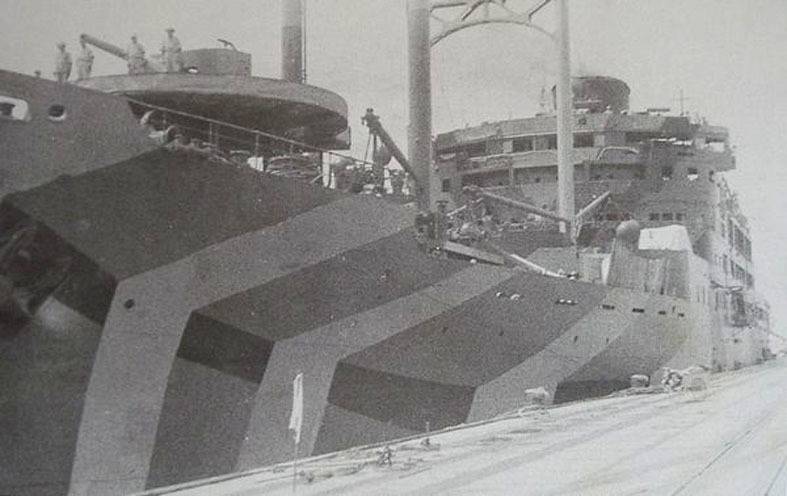
In general, pretty standard for the "auxiliary cruisers" of that time. Enough to arrange a finale to any civilian ship, which, on the whole, this sweet couple did. Moreover, quite successfully.
The Japanese raiders had at that time the sunken American steamboats Vincent and Malama, the British steamboat Elysia, the captured Dutch tanker Genota, which the prize team had brought to Japan, and it became part of the Imperial fleet under the name "Oso", the New Zealand armed steamer "Hauraki", included in the fleet as a supply transport "Hoki-maru."
That is, in a very short time two raiders replenished the Japanese fleet with two ships. Plus, both ships regularly supplied fuel and food to submarines that operated in the area.
In general, they were busy with business.
On the morning of November 11, southeast of Cocos Islands, Hokoku Maru observers discovered a small convoy on the horizon — a single tanker escorted by an escort ship.
“Hokoku-maru” turned toward them, “Aikoku-maru” followed 6 miles. Hiroshi Imazato, captain of 1 rank, first decided to sink the warship, hoping that after that the tanker would surrender without a fight, as had happened with the Genota tanker and the Hauraki armed steamer.
They say for sure: if you want to ridicule the gods, tell them about your plans.
Now it’s worth talking about those who were caught up by the brave Japanese sailors.
The tanker was Dutch, called "Ondine", but was used (the Netherlands, as it were, were all) by the British fleet. The ship was even smaller in displacement than the Japanese Raiders (9 070 gross) and could move at the speed of as many 12 knots.
When the British put the tanker at their service, they armed it with one 102-mm gun and four anti-aircraft machine guns.
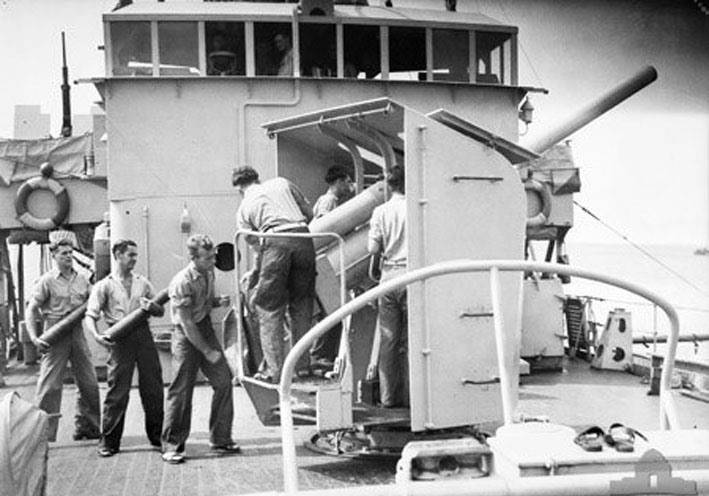
True, the calculations were not anyhow from where, but quite normal British cadres.
The second ship was the Bengal corvette. In general, according to the documents, he passed as a minesweeper, but as the minesweepers these boats were not actually used, but he was completely used as escort ships.
This was a series of ships of the Buthurst project, which they began to call corvettes. The Buthurst Corvette had a standard displacement of 650 tons and a full displacement of 1025 tons and could reach speeds of up to 15 knots.
The armament varied depending on what was available, but the usual set consisted of one 102-mm gun Mk XIX and three 20-mm “Erlikons”. To combat submarines, the Addic Type 128 sonar and up to 40 depth bombs served. The ships had good seaworthiness, so they were widely used to escort convoys and landing operations in the Pacific and Indian Oceans throughout the war.
So, two 102-mm guns against sixteen 140-mm and 12 nodes against 21.
In general, as Vladimir Semenovich sang in the song, “the alignment before the fight is not ours, but we will play.” Indeed, nothing dawned on the Dutch-Indian-British, since the gentle disposition of the Japanese was already notorious for everyone.
Observers from the Bengal discovered an unknown ship, and the corvette commander, Lieutenant Commander William Wilson ordered the ship to be deployed towards the unknown, at the same time breaking the alert.
Then the second raider drew after the first, both ships went without flags, but the British completely recognized the Japanese auxiliary cruisers in the ships. Everything became sad.
Wilson knew perfectly well that he won’t be able to leave; the Japanese have a huge speed advantage. Therefore, the captain decided to detain the raiders and allow the tanker to escape. And he ordered on the radio "Ondine" to leave on their own, appointing a meeting point.
And he went to the last and decisive battle towards the raiders.
In general, the idea was not bad: to approach the enemy at a minimum distance in order to use their anti-aircraft guns. “I won’t kill, so I’ll perforate.” Apparently, Wilson forgot about the torpedo tubes from the Japanese, or simply did not know.
But the Japanese were also happy with this, they hoped to drown the annoying corvette, and capture the tanker and send it to the metropolis.
And the Japanese ships opened fire on the Bengal.
A very strange event happened here. We will never know how frostbitten the psycho was the captain of the tanker Willem Horsman, but he was a very peculiar comrade.
Instead of trying to hide, Horsman estimated the chances of success (12 nodes against 21) and also went into battle!
And what? There is a gun, ammunition (as many as 32 shell !!!), gunners are British professionals, dying in battle is much better than rotting in a Japanese concentration camp or entertaining samurai as an object of torture.
And Horsman gives the command to go into battle too!
In general, the team of the British Commonwealth and the Netherlands attacked the Japanese raiders.
As I suppose, the Japanese missed because they were strangled by laughter. You can’t call such an attack anything more than suicide. On the other hand, according to the code of samurai honor, everything was just luxurious, the crews of British ships played on the same field with the Japanese.
But how…
The third shot of the Ondina hits the Hokoku-maru cabin. The sixth shot of the Bengal flies in there. The Japanese have some confusion ...
“Aikoku-maru” also began to shoot at the “Bengal”, but to get into this trifle was not easy. But then something happened that put the situation on its head. Another shell hits the Hokoku Maru.
The debate about who got in was very long. It is clear who the crews of both ships stood for what they were, but in any case, the shell sent by the British gunners hit.
And he got not just somewhere, but into the starboard torpedo tube, which stood under the hinged platform on which the seaplane was located.
Both torpedoes in the vehicle, of course, exploded. The plane was thrown overboard, but flying away, he beat the barrels of fuel, the fuel spread and caught fire, and then flashed again. When the barrels of gasoline finally detonated, and from them the ammunition of the gun No. 3, which was also shot.
In short, such an indicative video on the topic of fire safety.
As a result of the fireworks, a hole was formed in the stern of the starboard side, reaching the waterline. The Hokoku Maru began to roll to the starboard side and gradually sink. Although the Japanese did not stop shooting at the Bengal, and in the end, they still hit.
True, the British planted several more shells in the Hokoku-maru cabin, but this did not have any significant impact. In general, everything went well, the raider not only burned, but they could not put out it at all.
"Hokoku-maru" was not built as a military and therefore did not have the required number of internal bulkheads, and the fire extinguishing system was not designed to burn in hundreds of liters aviation petrol. As a result, the fire caused by gasoline reached the engine room, and soon all the ship's power supply failed.
The Hokoku Maru left the battle and stopped shooting.
At Bengal, it was decided that it was time to tear the claws, because the Aikoku-maru was unharmed, but the shells on the corvette were over. Because the British decided that enough was enough, they tried to hide behind the smoke screen, but the smoke buoys did not work. And the Japanese began to pursue the corvette, while at the same time trying to get into it, at least for the sake of decency.
Hit. The shell exploded in the stern, in officer cabins. There were no casualties, as the officers were busy, there was a fire that could quickly put out.
The Japanese were in a difficult position. On the one hand, the Bengal showed a desire to get out of the party, it turned out to get into the tiny corvette, but on the corvette they still managed to turn on the smoke. On the other hand, Ondina also gathered somewhere in the direction of the horizon. But the raiding comrade obviously didn’t feel very well.
About an hour after the start of the battle, Captain Imazato, the commander of the Hokoku-maru, received extremely unpleasant news that the fires were not only not put out, but he was also approaching the stern artillery cellar.
Captain Imazato ordered the crew to leave the ship, but not everyone managed to do this, because literally a few minutes later the Hokoku-maru exploded. A column of smoke and flame rose a hundred meters, and when the smoke cleared, only small fragments remained on the surface of the sea. Of the 354 crew members, 76 was lost, including the ship's commander.
The Japanese were frankly shocked by this situation, and ... they missed the Bengal, which under cover of a smoke screen managed to leave.
Captain Wilson ordered to find out the damage. Of the approximately two hundred 140-mm shells fired at Bengal, only two hit the ship. Accordingly, all add-ons were cut by fragments, there were two holes above the waterline, the demagnetization winding was damaged, but all 85 crew members were intact. No one was even injured.
Not finding the “Ondine” at the meeting point, Wilson ordered to move to the island of Diego Garcia. There Wilson reported that Ondine had died.
The British command appreciated the battle of Bengal and all sailors were awarded, and Wilson received the Order of Outstanding Merit.
Since the damage to the Bengal was very slight, after a short cosmetic repair, he continued his service. At the end of the war he remained in the Indian Navy and for a long time served in it as a patrol ship. Bengal was sent for scrapping only in the 1960 year.
And with Ondina, everything was somewhat contrary to Wilson's report. The Aikoku-maru, having lost sight of the Bengal, turned back, deciding to deal with the tanker, which nevertheless got several shells.
Naturally, the raider easily caught up with the tanker, which had already shot its huge ammunition from 32 shells. The Aikoku-maru opened fire virtually point-blank, and Captain Horsman, being an original man, but not crazy, ordered to stop the tanker and raise the white flag, and the crew to leave the ship.
Unfortunately, while the flag was lowered and the white flag was hoisted, the Japanese managed to release a few more shells. The latter fell into the wheelhouse, and a brave Dutch captain was killed.
The team was able to launch three lifeboats and two rafts, and began to move away from the doomed ship.
The Aikoku-maru went up a couple of cables to the Ondin and fired two torpedoes into its starboard side. The tanker banked at 30º after the explosions, but remained afloat.
The Japanese, meanwhile, took up their usual sport, that is, shooting boats. They fired, I must say, very badly. About the same as for ships made of guns. Apart from the captain, four of the Ondina crew died: a senior mechanic and three drivers.
Having finished having fun shooting at the unarmed crew of the tanker, the Japanese sailors decided that they should deal with the rescue of their colleagues from the drowned Hokoku-maru.
Perhaps this is precisely what saved the Ondina team from total destruction. In addition, the Japanese were clearly nervous, not being sure that the British ships had not given alarms and that British or Australian cruisers were not rushing to the area.
Therefore, having caught the remnants of the crew of the failed raider from the water, they discovered on the Aikoku-maru that the tanker stubbornly did not want to sink. Then on the "Ondine" fired the last available torpedo and ... missed !!!
In principle, it is logical if the Japanese really began to get nervous.
It could have been finished off with guns, but the captain of Aikoku-maru Tomotsu decided that it would do. The tanker sooner or later, but will drown, because the raider turned around and went to Singapore.
But Ondine did not sink. When the Aikoku-maru hid behind the horizon, a serious discussion broke out in the dangling boats on the waves. The first assistant captain, Rehvinkel, who took over the command, ordered the team to return to the tanker and take up rescue.
People had to be persuaded for quite some time, and not without reason, since a fairly battered ship could sink at any moment.
However, the team was matched by its captain, and a group of volunteers under the command of the second assistant Bakker and engineer Leys boarded. It turned out that everything is not so bad: the car is not damaged, the bulkheads are intact, and the flow of water can be stopped.
Although, of course, the Japanese did a good job of Ondin. Six shells hit the tanker: two in the bow, three in the bridge and superstructure, and another in the mast. And two torpedoes on board.
In the end, we decided to fight for survivability. The fire was extinguished, patches started, the roll was straightened by counter-flooding of the compartments.
After 6 hours of insane work, a marine diesel was launched and Ondina dragged back to Australia.
The tanker did not know anything about the fate of the Bengal, which played a cruel joke. Ondina requested help on air in clear text, since all secret ciphers and codes were thrown overboard before the crew left the ship.
Since the Bengal crew had already reached the base and reported that the Ondine was Khan, the radiograms asking for help were perceived as a trap from the insidious Japanese. And it was decided not to respond to calls. Although in fact one could send a warship, but apparently, nothing was suitable in that area.
A week later, on November 17, a wrecked tanker was discovered by a patrol aircraft 200 miles from Fremantle. and the next day entered Fremantle's harbor, breaking 1400 miles in a week.
Noteworthy finale stories.
I already said about the Bengal and its crew, it turned out almost the same with Ondina. The entire calculation of the 102-mm tanker guns was awarded the Dutch bronze cross, and Captain Horsman was posthumously awarded the title of Knight of the Military Order of William 4-class.
Considering how the Japanese finished the tanker, they decided not to restore it, but turned it into a gas station for American submarines, deleting them from the fleet lists and putting them on jokes in Exmouth Bay on the west coast of Australia, where there was a base for American submariners.
However, already in the 1944 year, when the theater of operations began to expand, a shortage of tankers began to supply troops and ships. Ondin decided to revive and repair. And the tanker went for repair in the USA, and had to crawl for almost three months!
They repaired the Ondine in Tampa, Florida, and did it quite qualitatively, so the tanker served until the 1959 of the year and was scrapped only a year earlier than the Bengal.
More, however, the ships did not meet.
But who was unlucky was Aikoku-maru. After returning to Singapore, the ship was sent to Rabaul. There, the raider was actually demoted from the cruisers, disarmed and used further as a transport. It was sunk in the lagoon of Truk Island (Caroline Islands, Micronesia) during Operation Hilston by US aircraft.
Captain Oishi Tomotsu spent six months under investigation, in April 1943 of the year he was removed from the post of commander of the vessel and transferred to the coastal service.
In conclusion.
And it is not for nothing that they say that the gods patronize the brave and courageous. In fact, the suicide attack of the corvette and the tanker on the auxiliary cruisers turned into a triumph of the fighting spirit of the British sailors and their allies and simply a terrible humiliation of the Japanese.
Did the case help? There are no such cases. Accurate sight, not trembling hands and all the rest - and here is the result.
There was something like this, Nashensky, in this battle. Therefore, as a demonstration of respect for the British, Dutch, Indians and Chinese, he put this epigraph to this story.
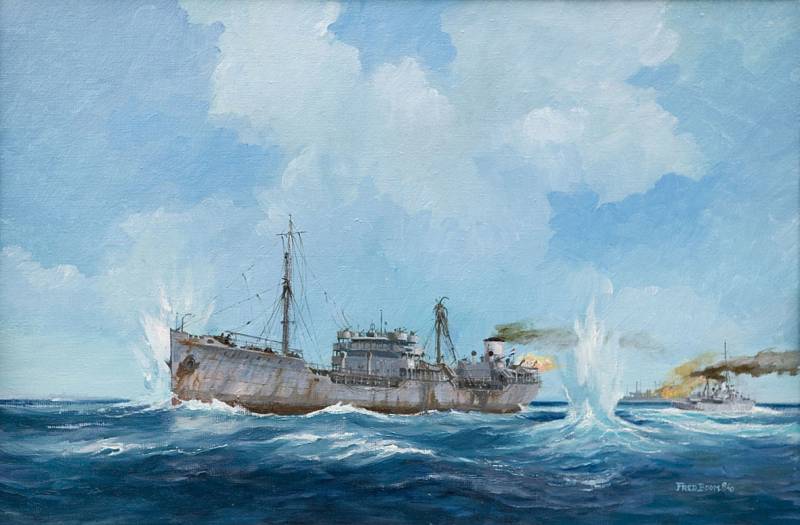
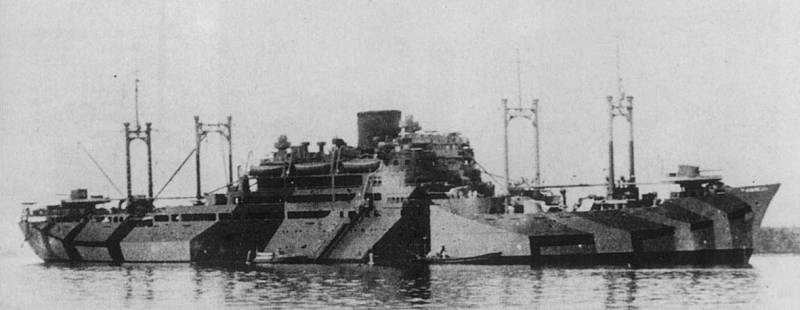
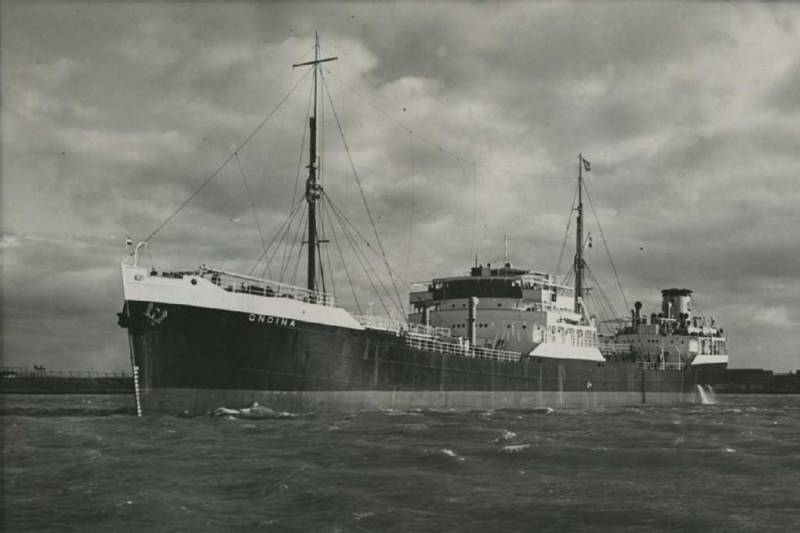
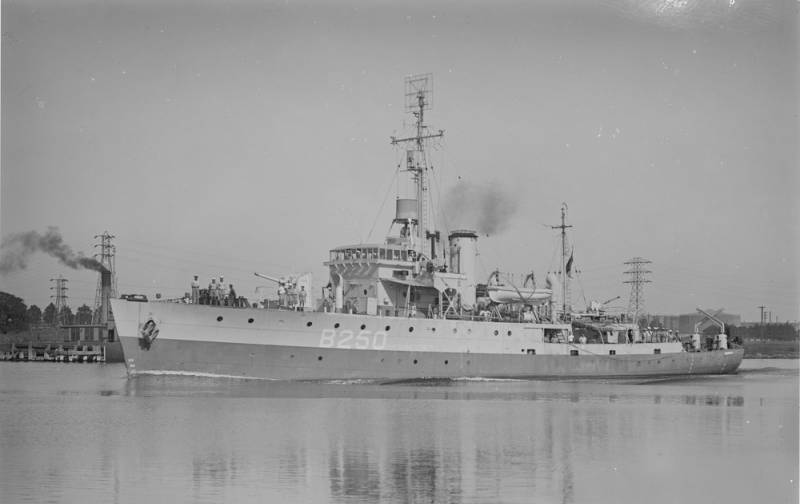
Information